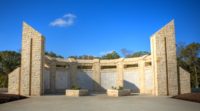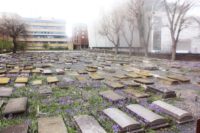It’s generally held to be the case that alumni of US universities have a much stronger affinity to their almae matres than those in the UK or most other countries.
There are many ways in which this can expressed, including through donations, engagement in alumni activities, reunion events, following the football team and excessive acquisition of branded merchandise and so on. There is also, as recently reported here, the opportunity to continue living on campus in a university retirement village after your working days have ended.
But there is another way too in which alumni can express their loyalty to their university. Forever. Whilst at the same time enabling their institution to make a little bit of extra money. All for the ideal resting place. For example there is this opportunity at Norwich University where a peaceful final resting place known as the Dole Farm overlooks one of the university’s campuses.
Alumni (including non-graduates), friends, employees, trustees and their families may inquire about a plot or lot in the cemetery.
Cost: Cremains – $770 | Plot – $1,100 | Lot – $2,200
And if you don’t want your own plot you can always buy a memorial bench or a tree to remember other members of the university community.

Norwich University seems to have a pretty open policy as far as admissions to the graveyard whereas others, often due to space limitations, are a lot more restrictive.
The rules at Clemson University are quite detailed and you have to have more than 20 years service or be a dead president in order to qualify for a plot. Interim presidents need not apply.
Denison College has a similarly exclusive policy and is open only to presidents and professors. It’s been there since 1833.
At Texas A&M university, you can be laid to rest in the ‘Aggie Field of Honour’ – this is a more inclusive cemetery though and is also a municipal graveyard.

The history of the cemetery at the University of Virginia is a particularly interesting one:
Founded in 1828, the Cemetery at the University of Virginia is the resting place for hundreds of individuals connected with the university, including former university presidents, professors, and students.
During the Civil War, a new portion of the cemetery was created to accommodate the rising number of Confederate dead. This portion of the cemetery –known as the Confederate Cemetery– contains the remains of 1,097 Confederate soldiers, including two Confederate Generals.

This history has inevitably caused some challenges and the university has sought carefully to distance its own University Cemetery from the Confederate Cemetery:
though the two adjoin one another, they are not technically part of the same cemetery. However, when the cemetery was built, the division between the Confederacy and the University was not so stark. 515 of UVA’s 600 enrolled students served in the Confederate Military
There is also an African American cemetery on the site too which was discovered only relatively recently and contains a set of unmarked graves of those who were enslaved in the 19th Century:
The President’s Commission on Slavery at the University of Virginia is also working to preserve this rediscovered African American cemetery. The African American Cemetery has now been turned into a serene pasture and enclosed by a wooden fence. According to Brendan Wolfe, “the newly discovered graves will remain undisturbed and the site will be preserved and memorialized by the University.”
So there can be some really big issues in addressing graveyard issues in universities.
Whilst I don’t think any UK university has yet gone down the road of setting aside land for plots for professors there is one institution which has a famous graveyard on campus. Queen Mary has this extraordinary Jewish cemetery at its Mile End campus:

It’s a really remarkable place and there isn’t anywhere quite like it in the UK. There are many live issues then for universities in operating cemeteries.
(With thanks to Mike Ratcliffe for prompting this one.)













If universities had cemeteries they could bury the Augur Report
[…] Ideally such innovations will generate income as well as build brand loyalty. Perhaps not always in such a final way as we reported here a while back. […]